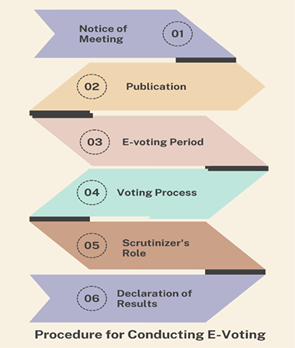The Companies Act, 2013, marked a significant shift in corporate governance in India by introducing electronic voting (e-voting) mechanisms. This initiative aimed to enhance transparency, increase shareholder participation, and streamline the decision-making processes within companies. By leveraging technology, e-voting facilitates a more inclusive and efficient approach to corporate voting, aligning with global best practices.
Legal Framework
E-voting in India is primarily governed by Section 108 of the Companies Act, 2013, and Rule 20 of the Companies (Management and Administration) Rules, 2014. These provisions outline the procedures and requirements for companies to facilitate electronic voting for their shareholders.
Section 108 empowers the Central Government to prescribe the manner in which members may exercise their right to vote by electronic means. Rule 20 details the procedural aspects, ensuring that the e-voting process is conducted transparently and securely.
Applicability of E-Voting Provisions
The mandate for e-voting applies to:
- Every listed company
- Every company having not less than 1,000 members
However, certain entities are exempted from this requirement, including Nidhi companies and enterprises or institutional investors referred to in Chapter XB or Chapter XC of the SEBI (Issue of Capital and Disclosure Requirements) Regulations, 2009.
Notably, companies not mandated to provide e-voting facilities may voluntarily adopt e-voting. In such cases, they must adhere to the same procedural requirements as mandated entities to ensure uniformity and fairness in the voting process.
Key Definitions in the E-Voting Context
To comprehend the e-voting process, it’s essential to understand certain key terms:
- Agency: Entities like the National Securities Depository Limited (NSDL) or Central Depository Services (India) Limited (CDSL) authorized to provide e-voting services.
- Cut-off Date: A date not earlier than seven days before the general meeting, determining the eligibility of members to vote.
- Electronic Voting System: A secure system that enables members to cast their votes electronically, ensuring the integrity and confidentiality of the voting process.
- Remote E-voting: Facility allowing members to vote electronically from a location other than the venue of the general meeting.

Procedure for Conducting E-Voting
The e-voting process involves several critical steps to ensure transparency and member participation:
- Notice of Meeting: The company must send a notice to all members, directors, and auditors, indicating the availability of e-voting facilities. This notice should be dispatched through registered post, speed post, electronic means, or courier service.
- Publication: An advertisement must be published at least five days before the commencement of e-voting in both English and vernacular newspapers, providing details about the e-voting process.
- E-voting Period: The e-voting window should remain open for at least one day and not exceed three days. It must close at 5:00 PM on the day preceding the general meeting.
- Voting Process: Members can cast their votes using the electronic voting system provided by the authorized agency. Once a vote is cast, it cannot be changed.
- Scrutinizer’s Role: An independent scrutinizer is appointed to oversee the e-voting process, ensure transparency, and submit a report on the voting results. The scrutinizer must be a person of repute who is not in employment of the company.
- Declaration of Results: The results declared along with the scrutinizer’s report must be placed on the website of the company and the agency immediately after the result is declared by the Chairman. In the case of listed companies, the results should also be forwarded to the stock exchange where the company’s shares are listed.
Benefits of E-Voting
The adoption of e-voting offers numerous advantages:
- Enhanced Participation: Shareholders, irrespective of their geographical location, can participate in the decision-making process without being physically present.
- Transparency and Security: E-voting ensures a secure and tamper-proof voting mechanism, enhancing the credibility of the voting process.
- Cost-Effective: Reduces the costs associated with printing and dispatching physical ballots.
- Time-Saving: Accelerates the voting process and the declaration of results.
Challenges and Considerations
While e-voting streamlines the voting process, certain challenges need to be addressed:
- Digital Literacy: Ensuring that all shareholders are comfortable with the e-voting process requires efforts in digital literacy and support.
- Technical Glitches: Technical issues can hinder the voting process; hence, robust systems and contingency plans are essential.
- Data Security: Protecting sensitive shareholder information is paramount, necessitating stringent cybersecurity measures.
Conclusion
The introduction of e-voting under the Companies Act, 2013, signifies a progressive step towards modernizing corporate governance in India. By facilitating greater shareholder engagement and ensuring a transparent voting process, e-voting strengthens the democratic fabric of corporate decision-making. As technology continues to evolve, companies must adapt and refine their e-voting mechanisms to address challenges and harness the full potential of digital participation.
